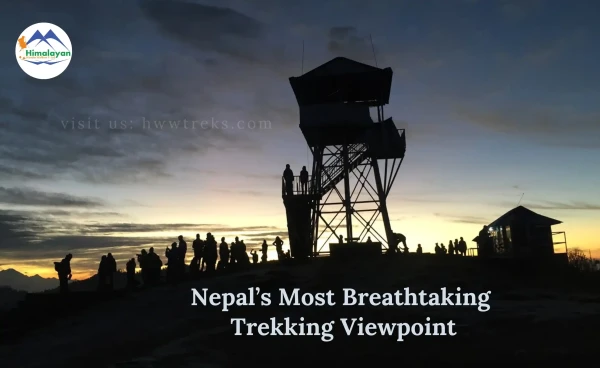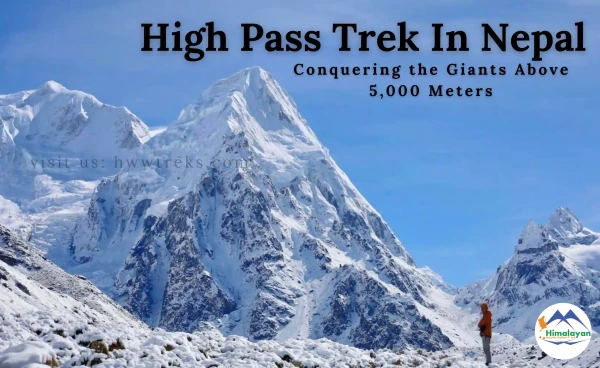- 11/27/2025
- Tags: Trekking in Nepal
- Himalayan Wander Walkers
Why To Trek In Nepal
Nepal, being a Himalayan country like no other, it's not just a small place on a map; it's an address for 8 of the world's highest mountains, not forgetting the famed Sagarmatha (Mount Everest), home to the light of Asia (Lord Gautam Buddha) and the living goddess Kumari. Nonetheless, Nepal is not just limited to this; it is much more than the peaks and Buddha. Nepal has a wide ranges of biodiversity that never fail to amaze the world, and its untamed landscape always has something new for all the travelers and trekkers.
Annually, more than a million individuals visit Nepal, making it not just a place for vacation but a place where one can gain experience regardless of what you are seeking. When people travel to Nepal, they do not just focus on reaching the destination; they are compelled to enjoy every journey and trail they come across. That’s why Nepal stands unmatched as the world’s ultimate trekking destination, and here are some reasons why you should trek in Nepal and add it to your bucket list.
Contents [hide]
- 1. Endless Trekking Routes
- 2. All Year Round: Nepal’s 4-Season Advantage
- 3. Nepal’s Breathtaking Biodiversity
- 4. Unique Landscape Diversity
- 5. A Walk Through Living Culture & Ancient Spirituality
- 6. Food on the Trail: More Than Just Dal Bhat
- 7. Trekking for Every Budget
- 8. Benefits of trekking in Nepal
- 9. Hospitality in the Himalayas
- Conclusion
1. Endless Trekking Routes
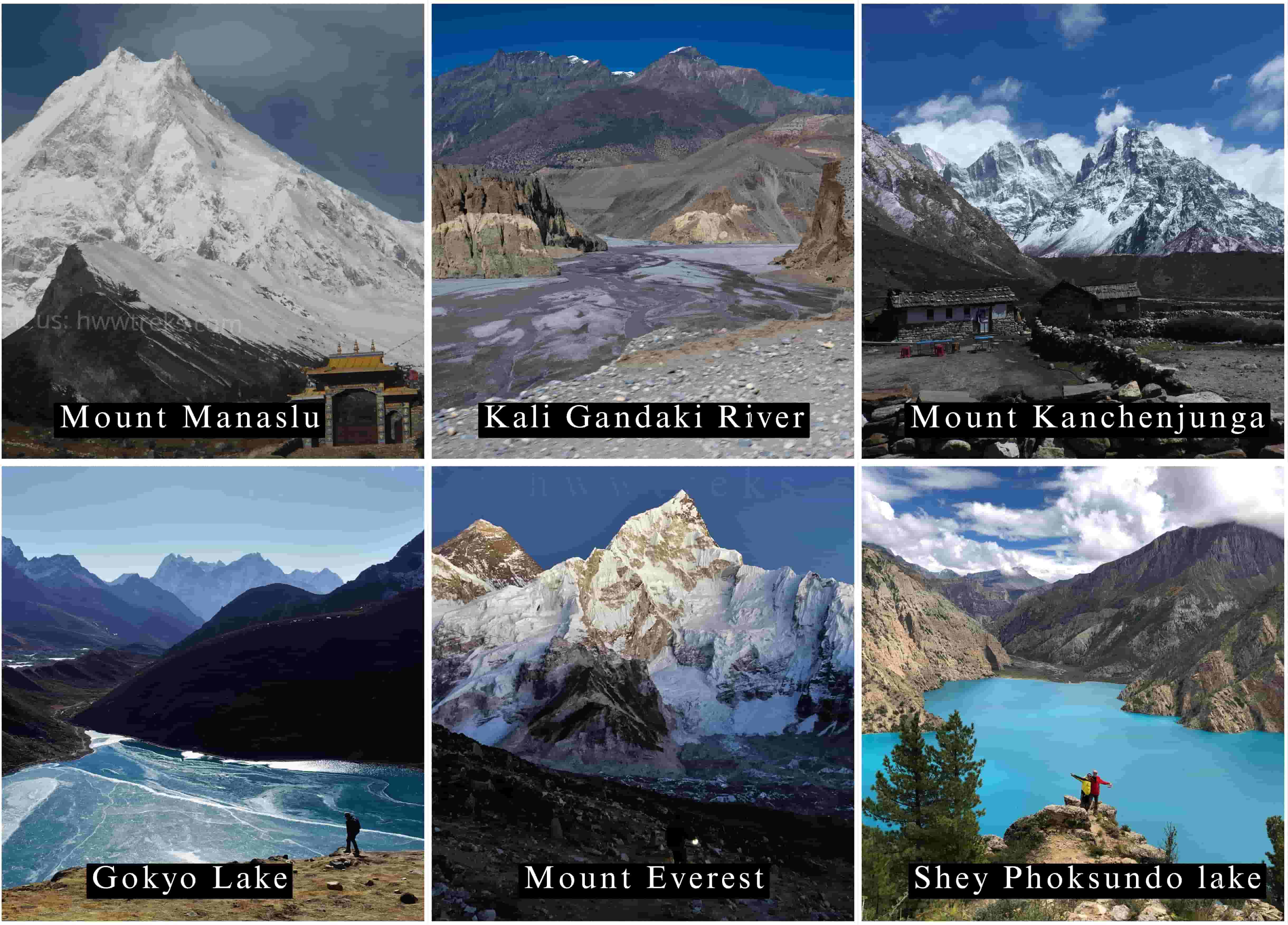 In Nepal, there are more than 1,310 peaks exceeding 600 meters, 66 districts, 6 conservation areas, and many more trekking regions and destinations for one to explore. One can spend their whole life here and still be amazed by the variety of trekking routes. There is always something for everyone, whether you are an experienced hiker, a trekker, a newbie, or a spiritual seeker.
In Nepal, there are more than 1,310 peaks exceeding 600 meters, 66 districts, 6 conservation areas, and many more trekking regions and destinations for one to explore. One can spend their whole life here and still be amazed by the variety of trekking routes. There is always something for everyone, whether you are an experienced hiker, a trekker, a newbie, or a spiritual seeker.
Nepal’s variety of trekking destinations will surely answer your question, “How to choose the best trek in Nepal?” One can pick from the iconic classic treks, such as the Everest Base Camp, Annapurna Circuit (either via Thorang La Pass or via Tilicho Lake), and Mardi Himal, or can do treks off the beaten path, such as the Dolpo Region, Manaslu Region, Kanchenjunga Region, and beyond. One can also go for the restricted area destinations such as the Mustang region and Tsum Valley, which have been open to outsiders since the 1990s and 2000s. A beginner can choose to trek to Poon Hill, Ghorepani, and Langtang Valley, whereas a person looking for adventure and thrills can choose to trek to Gokyo Lake, Kanchenjunga Circuit, and several others. If you are experienced in climbing, then you should show your skill and leave footprints on the peaks of Nepal by choosing peak climbing activities on Island Peak, Mera Peak, Saribung Peak, and many others. If time doesn’t allow, then one can also go for short treks and day trips, which are no less than long-day trekking.
Best of all, if you have decided on the trekking destination, while looking at the prebuilt itinerary, as long as it doesn’t suit your schedule or skill level, you can customize it at any time, making it according to your preferences.
2. All Year Round: Nepal’s 4-Season Advantage
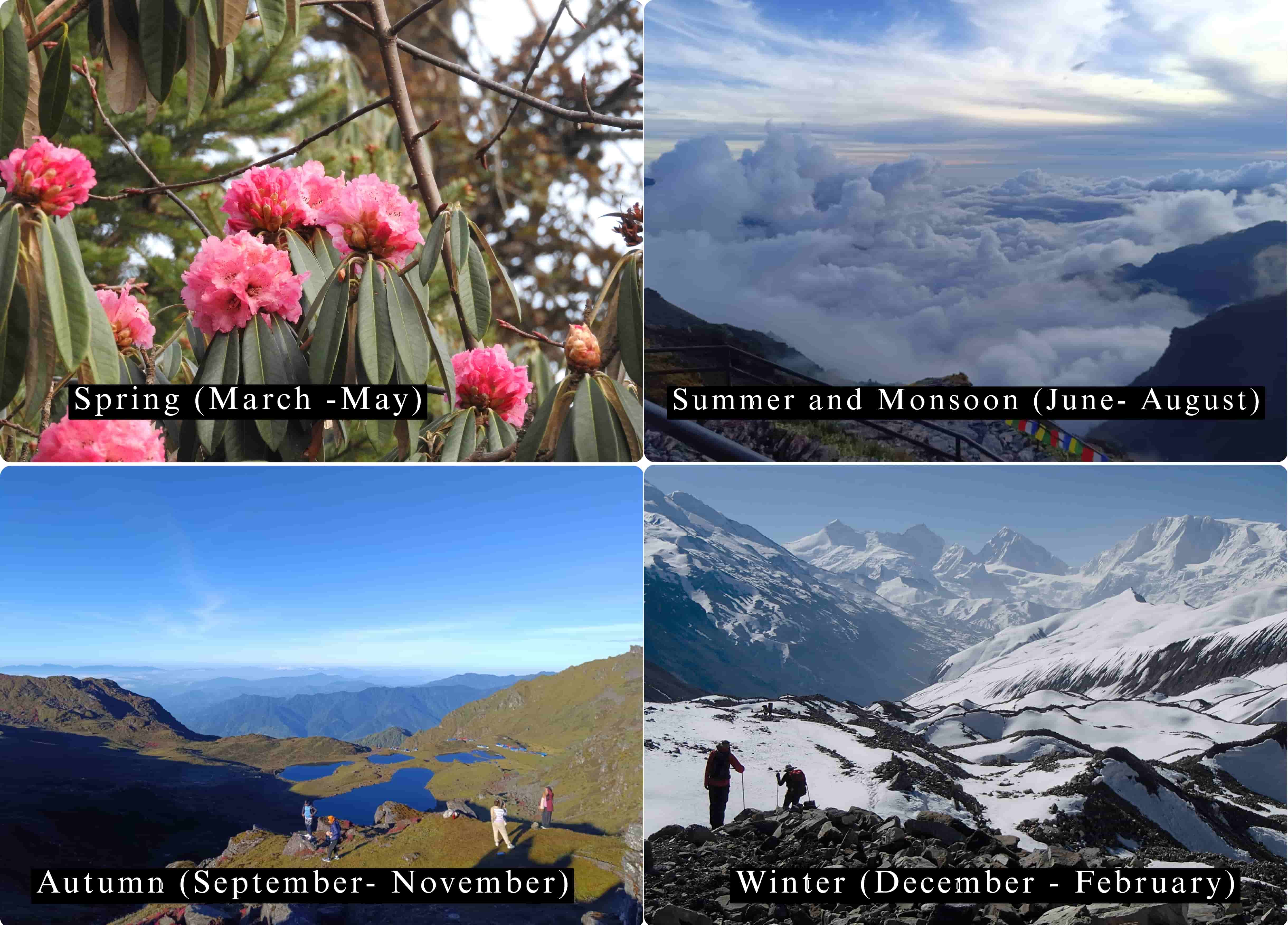 In Nepal, there’s no such thing as the best season to trek, since trekking is suitable and popular in all seasons and all year round. With proper backups and preparation, one can choose to trek anytime. Each season brings its unique gift to nature, making the same trekking region and route feel distinct and special in every season. Here’s what to expect and the best trekking spots for each season, detailed below.
In Nepal, there’s no such thing as the best season to trek, since trekking is suitable and popular in all seasons and all year round. With proper backups and preparation, one can choose to trek anytime. Each season brings its unique gift to nature, making the same trekking region and route feel distinct and special in every season. Here’s what to expect and the best trekking spots for each season, detailed below.
Spring (March-May)
Spring is the most colorful season among the four. During this time of the year, one can see the most popular and national flower of Nepal, Laliguras (Rhododendron), along with many other flowers on the hillside of the trails. Spring offers pleasing weather with clear skies and modest temperatures.
During this season, the Annapurna and Everest Region trek is most suitable, as it offers clear views of the surroundings and minimizes the risk of altitude sickness and others. There are a number of the best treks that one can do in Nepal during this season.
Summer and Monsoon (June-August)
Summer brings unscheduled rainfall along with warm and humid air. The hilly regions maintain cool temperatures, whereas the Terai region will be scorching hot. During this season, there’s a clear sky except on rainy days, and there are many lush greenery scenes with wildflowers all over. Even for the wet days, one can do trekking, but must be ready for the slippery roads and the leeches. The view after rain is breathtaking, as there will be a clear sky with the awe-inspiring vistas of the mountains.
The rain shadow areas, such as Upper Dolpo, Upper Mustang, and the Nar Phu valleys, are the most fitting treks for the season. Whereas if one wants to enjoy the monsoon season, then the Dhorpatan trek, the Kori trek, or the Mardi Himal trek are the best choices, where one gets to see the different wild flowers and greenery everywhere. One can also witness the famous Tiji festival and horse racing Yatrung festival of the Mustang region, which fall during June and August, respectively. There is less trekking and travelling during this season, so one will get to enjoy the peace and solitude along the trail.
Autumn (September-November)
Autumn brings the clear sky left by the monsoon season and the dry air that winter will bring further. During this season, the weather is crisp with the green and golden colors of nature and clear mountain views. One can enjoy the day with a hike or trek without worrying about rain or the burning sun. It's the season of the long-awaited festival, Dashain and Tihar, which surely will add a new experience.
During this season, one can trek to any region, including the Manaslu region, the Kanchenjunga region, the Makalu region, or even the Everest region. All the trekking hubs get active during this season, so one gets to see the busy life of the region.
Winter (December - February)
Winter in Nepal differs according to places, as it is cold and foggy along with clear skies in the noon and evening in Kathmandu, whereas the peaks and the houses are covered in snow in the Himalayan region. The winter season can be harsh to mildly cold, depending on the altitude. All the peaks and mountains come alive with the snow.
During this season, it is best to avoid highly elevated regions to get rid of altitude sickness and to choose those treks with stable routes or trails. The Langtang Valley Trek, Mardi Himal Trek, or Ghorepani Poon Hill Trek are suitable for the season.
3. Nepal’s Breathtaking Biodiversity
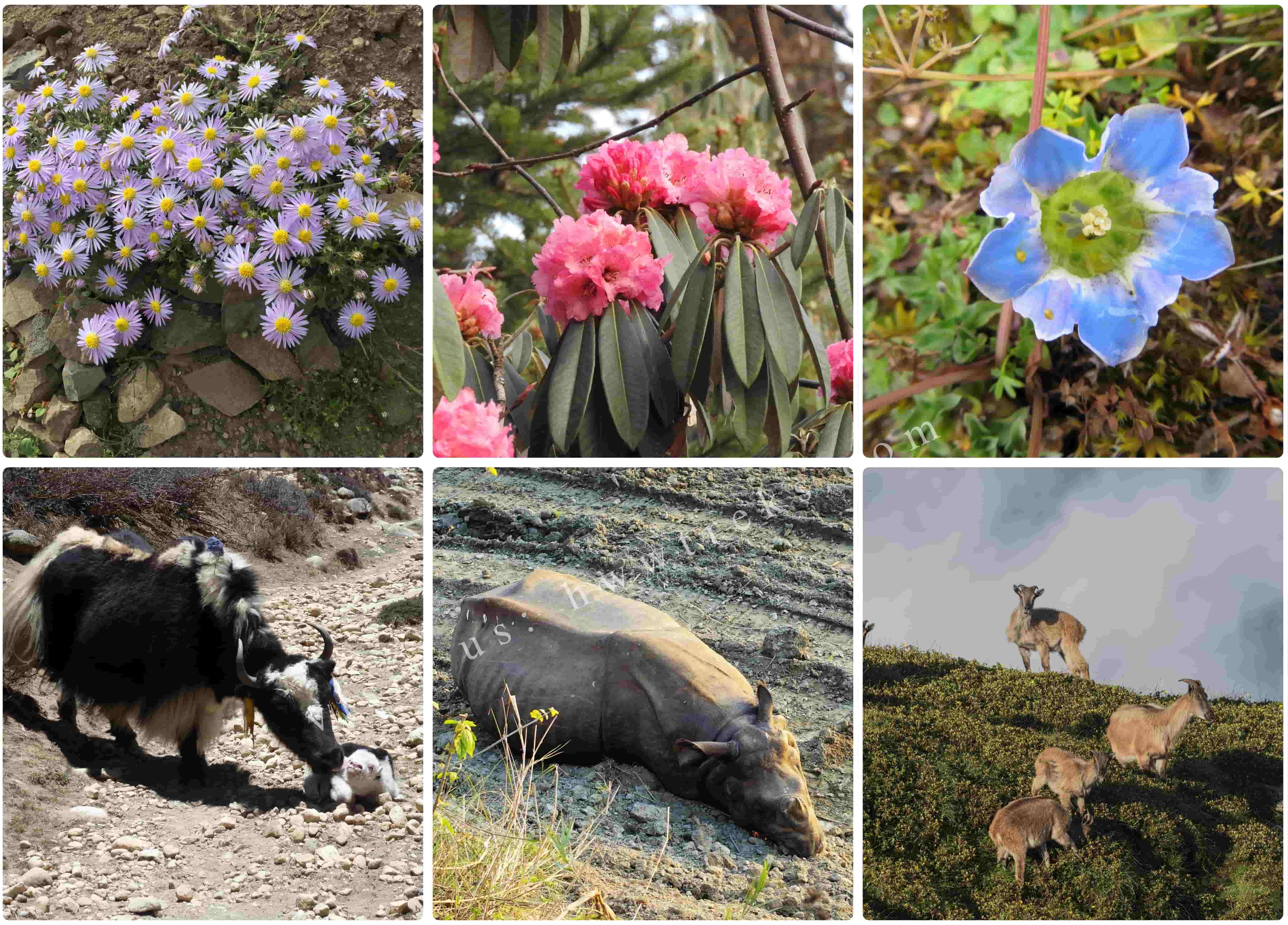 Roughly, Nepal covers 0.03% of the world, yet it is rich in biodiversity compared to other larger lands. Nepal is home to 692 species of small and colorful butterflies and to the ghost of the mountain, the snow leopard. Due to the varied topography and climate in Nepal, it has a wide range of forests from subtropical to alpine. Across the country, there are more than 118 distinct ecosystems, 75 types of vegetation, and 35 recognized forest types. These forests provide vital habitats for over 6,973 species of flora and on top of 17,097 species of fauna, including mammals, birds, reptiles, and fish.
Roughly, Nepal covers 0.03% of the world, yet it is rich in biodiversity compared to other larger lands. Nepal is home to 692 species of small and colorful butterflies and to the ghost of the mountain, the snow leopard. Due to the varied topography and climate in Nepal, it has a wide range of forests from subtropical to alpine. Across the country, there are more than 118 distinct ecosystems, 75 types of vegetation, and 35 recognized forest types. These forests provide vital habitats for over 6,973 species of flora and on top of 17,097 species of fauna, including mammals, birds, reptiles, and fish.
While trekking in Nepal, one can witness over 30 different kinds of Laliguras (Rhododendron), which can be used in medicines, further with many unique plants such as Yarsagumba (Ophiocordyceps sinensis), Himalayan blue poppy, and so on. One can also get a glimpse of many unique and endangered animals; to give an example, the snow leopard, a big famous mountain cat that resides around the Rara National Park and the Upper Dolpo Region; the red panda, which exists in the bamboo forests of Kanchenjunga and Langtang National Parks; and the one-horned rhino, which can be found in the Chitwan and Bardiya National Parks. Also, the Himalayan Musk deer, the Gharial (an endangered crocodile species), the Himalayan monal, and many more living creatures are found in the land of Nepal
These are enough to prove that Nepal is a paradise for zoologists and biologists, and also for those who love nature’s creation. So, why not trek in Nepal’s regions and try your luck? You might get a chance to witness those colorful butterflies, the unique and endangered animals, and also the pride of Nepal, the Laliguras.
4. Unique Landscape Diversity
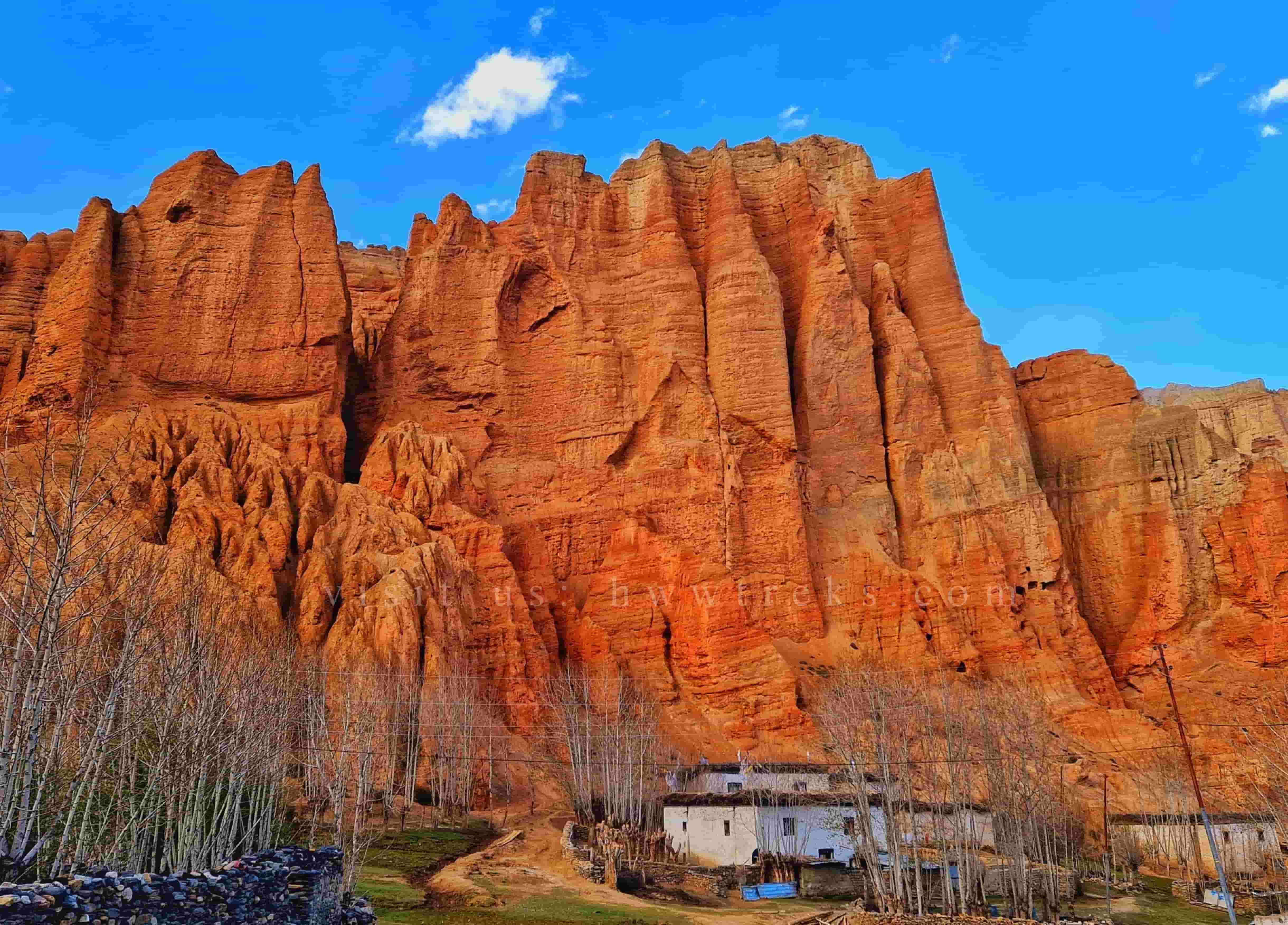 Nepal is divided into three regions: the Himalayan, Hilly, and Terai regions, and each region has a manifold landscape within itself. More than 600 rivers are roaring from the great Himalayas to the lowlands, including the largest, Karnali River, to the smallest stream, Likhu Khola of the Saptakoshi River. And all these rivers are supported by the great protector and natural wall, the peaks and the mountains of Nepal. The water flowing from these towering peaks and mountains forms glaciers and lakes, adding more beauty to the topography.
Nepal is divided into three regions: the Himalayan, Hilly, and Terai regions, and each region has a manifold landscape within itself. More than 600 rivers are roaring from the great Himalayas to the lowlands, including the largest, Karnali River, to the smallest stream, Likhu Khola of the Saptakoshi River. And all these rivers are supported by the great protector and natural wall, the peaks and the mountains of Nepal. The water flowing from these towering peaks and mountains forms glaciers and lakes, adding more beauty to the topography.
Apart from the pinnacles, one will experience multiple climates within a week while trekking in Nepal. The Himalayan region holds a crispness in its air, whereas the hilly region has the warmth of gentle sunshine. One gets to see different forms of natural color in the guise of monasteries, caves, hills, forests, and mountains. The Mustang region, with its pure shades of red and gold, is one of the finest examples. Also not forget the majestic Shey monasteries and other Bon abbeys of the Dolpo region, where the sky-scraping hills act as a part of the Gompa. While the Himalayan region boasts breathtaking vistas of peaks, glaciers, and caves, the Terai region offers the beauty of lush greenery and a serene, calming nature, with its amazing array of living creatures.
5. A Walk Through Living Culture & Ancient Spirituality
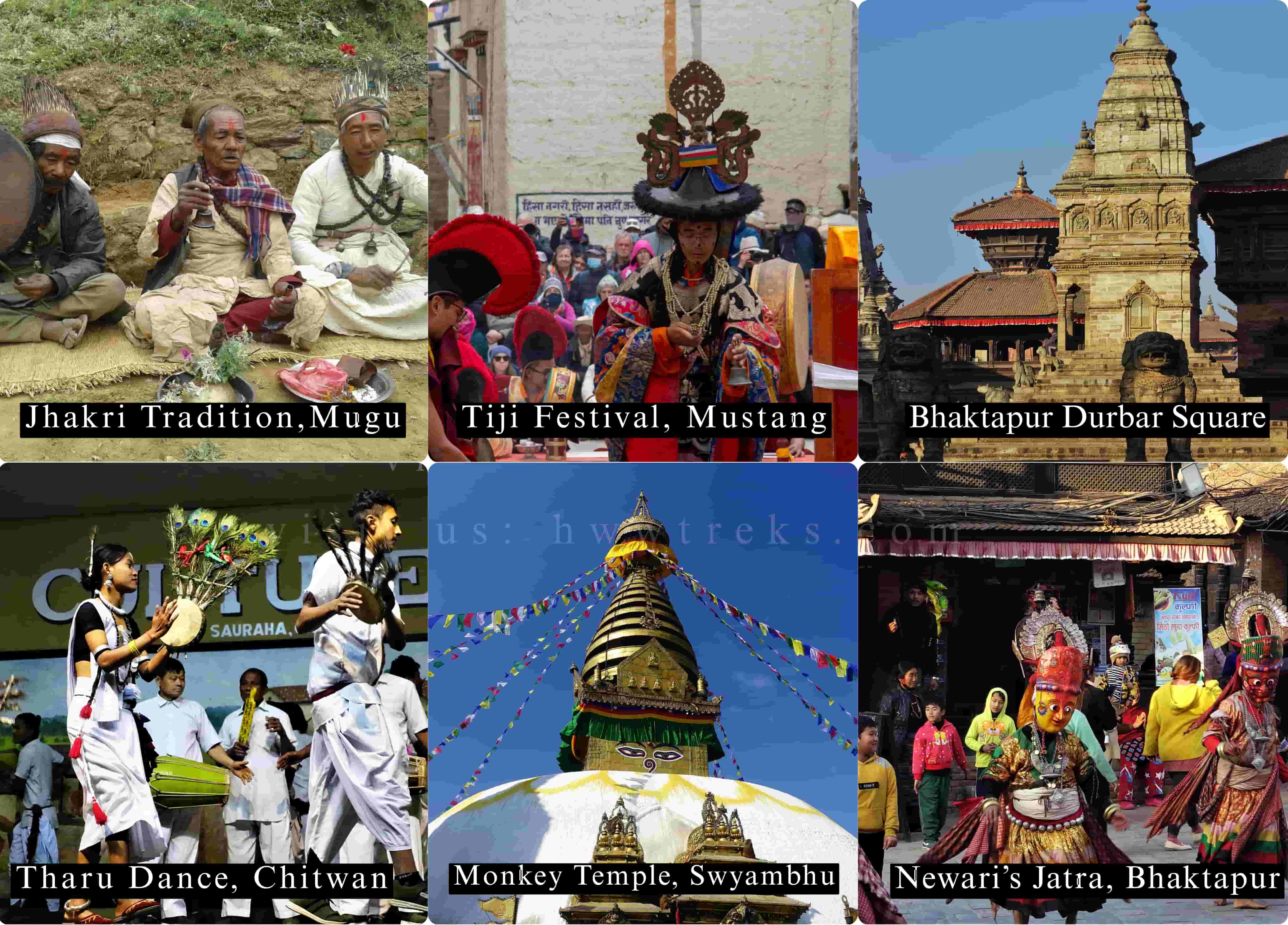 When talking about culture, Nepal has never been behind. Being a multi-religion, multi ethnic country, you will find diverse languages, traditions, and cultures in every corner. Within Kathmandu alone lie seven UNESCO World Heritage Sites, several royal palaces, and countless Tibetan monasteries and mosques. The valley is a living, breathing museum and home to the ancient Pashupatinath Temple, one of the oldest Hindu temples in the world.
When talking about culture, Nepal has never been behind. Being a multi-religion, multi ethnic country, you will find diverse languages, traditions, and cultures in every corner. Within Kathmandu alone lie seven UNESCO World Heritage Sites, several royal palaces, and countless Tibetan monasteries and mosques. The valley is a living, breathing museum and home to the ancient Pashupatinath Temple, one of the oldest Hindu temples in the world.
But the real magic for trekkers lies beyond the city, in the mountain and hilly region of Nepal. While trekking among the Tamanag, Magar, Rai, Limbu, and Sherpa communities, you will see that the people still practice shamanic (Jhakri or Dhami) traditions. These traditions are normally passed down orally from a master to their disciples. Nepal’s trekking routes are not just a walking trail; they are a journey through the living culture where you might walk along the ancient village of Upper Mustang, witnessing the auspicious Tiji festival along with the villagers. Never to forget the Dolpo region, where the Bon (pre-Buddhist religion) and the Buddhist tradition thrived together for centuries, where the majestic Shey Gompa and Shey Phoskundo lake stand as timeless symbols of its spiritual and natural glory. The monasteries like Tengboche and Thubten Chöling of the Everest region are not solely religious sites; they are community hubs where locals gather for festivals such as Mani Rimdu, marked by masked dances and chanting that have been performed for centuries. Also in the Gurung Village of Annapurna region, you will be welcomed with the Rodhi Ghar, whereas the Magar community of Rolpa still performs the drumming and war dances during Maghe Sankranti.
One of the major charms and strengths of Nepal is its festivals and rituals. The biggest and the longest Dashain and Tihar, the most playful Holi, the spiritual Budhha Purnima, both Nepali and Tibetan New Year (Losar), and several others are the opportunity for trekkers and travellers to experience the warm hospitality and local’s way of celebration where every village became a stage for music, dance, culture and traditional food.
This is why trekking in Nepal is more than just a physical adventure. It is walking through a landscape where nature and spirituality are inseparable, where every step is a warm touch with living history.
6. Food on the Trail: More Than Just Dal Bhat
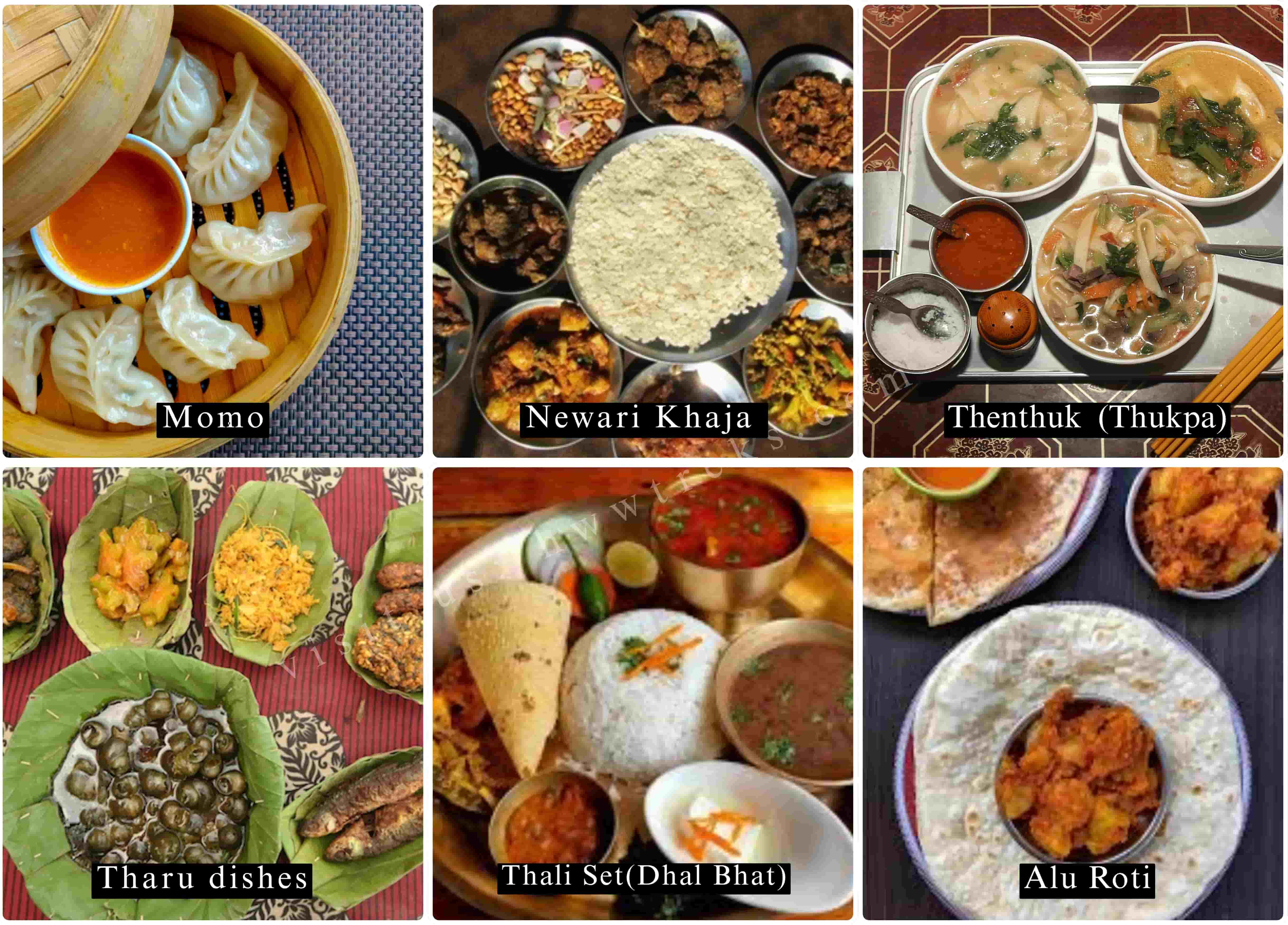 In the course of trekking and travelling in the mountain region, one of the most important questions or thoughts that pops up on everyone's mind is “What do trekkers eat in the mountains?”, or “Will there be enough nutritious/ good food?”
In the course of trekking and travelling in the mountain region, one of the most important questions or thoughts that pops up on everyone's mind is “What do trekkers eat in the mountains?”, or “Will there be enough nutritious/ good food?”
To answer and remove this question from your mind once and forever, think of all the porters, trekking guides, and locals of the mountain, who are strong enough and healthy enough to guide you through the top of the world. What do you think they eat daily?
During trekking, one will be served fresh and local meals, which will not only make your stomach full but will also keep you energetic and healthy throughout the journey. There will be many Western dishes, including burgers, fries, and pizzas, but the regional dishes are highly recommended for a new experience. After all, why travel all these trails just to eat the same food you get in the city?
Nepal has a large number of delicacies to suit your taste. Not just the famous Dal Bhat, but the local Tibetan bread, yak cheese, toasted barley, momos, thukpa, and many more. A lot of ethnic people have their local dishes. Newar’s popular dishes include the Chatamari, Yomari, Bara, Samay Baji, whereas Ghonghi (snail dish), Dhikri (steamed rice cake), Bagiya (another steamed rice flour dish), Bhakka (another rice cake), and Pakuwa (barbecued meat) are popular among the Tharu community. For vegetarians, there is a lot of variety and options available. One can choose to have Samosas and Shel roti from local vendors, to veg Dhal Bhat, thukpa, momo, and other veg items from fancy hotels.
7. Trekking for Every Budget
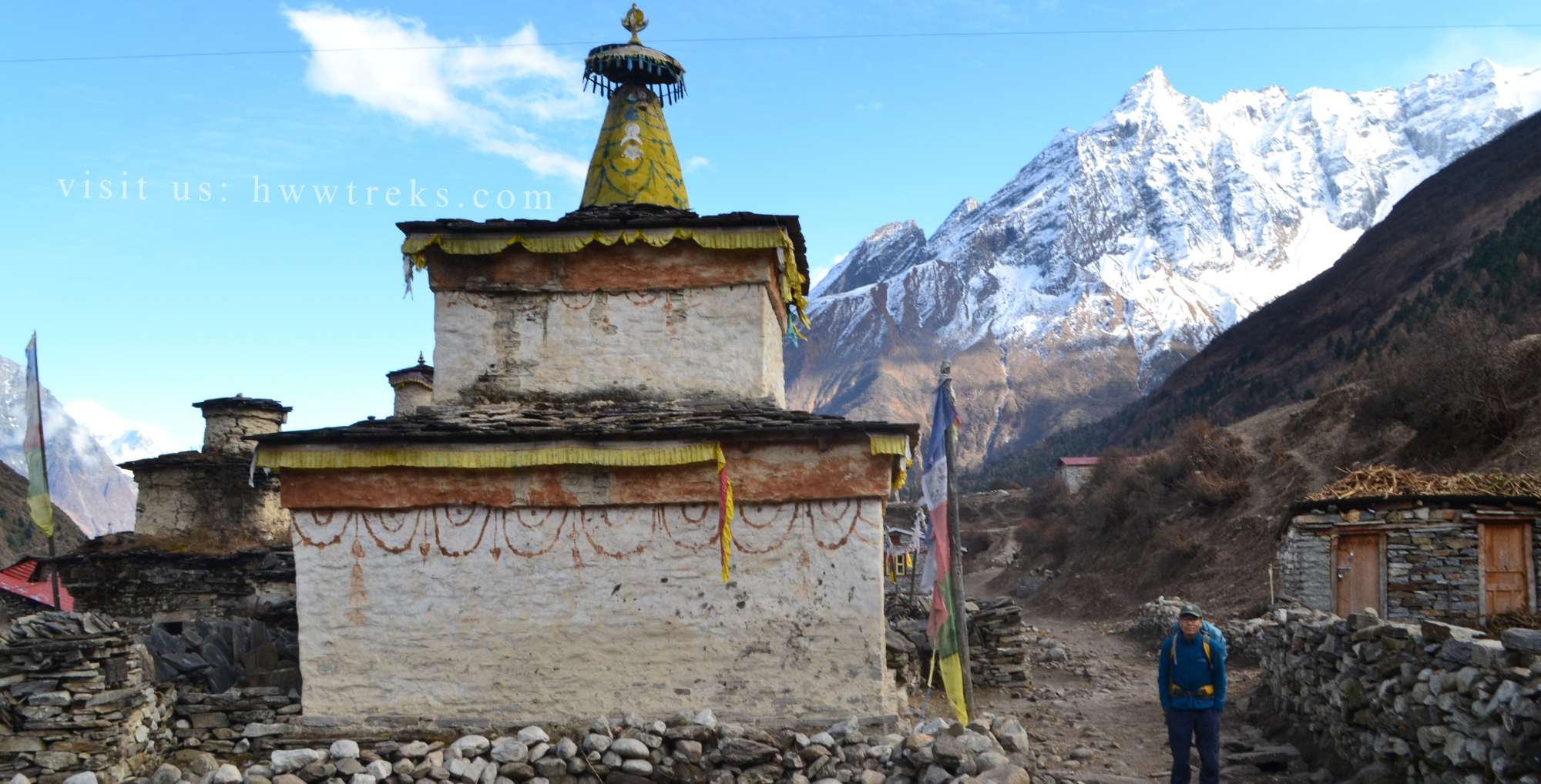 Trekking in Nepal has been a lot easier, comfortable, and accessible, and has never been limited to a certain amount of money. There’s always something for everyone, and its cost depends on how much you want to spend. Nowadays, one can choose how they want to travel, where they want to stay, and what food they want to eat. Likewise, one can choose whether they want a luxury trek, such as a heli tour to Everest Base Camp, or their own choice of destination, or a budget-friendly trek, including the Poonhill Ghorepani trek or the Langtang Valley trek.
Trekking in Nepal has been a lot easier, comfortable, and accessible, and has never been limited to a certain amount of money. There’s always something for everyone, and its cost depends on how much you want to spend. Nowadays, one can choose how they want to travel, where they want to stay, and what food they want to eat. Likewise, one can choose whether they want a luxury trek, such as a heli tour to Everest Base Camp, or their own choice of destination, or a budget-friendly trek, including the Poonhill Ghorepani trek or the Langtang Valley trek.
There are two types of trekking, such as the campaign trek, where all the trekking equipment, namely tent, cooking material, and bed sheet all are carried along the way by the trekking crew member. The most famous camping trek of Nepal is the Upper and Inner Dolpo trek. Another type of trekking is the tea house trekking, where one’s food and lodging are provided in the local tea house and restaurant. Upper Mustang trek, Kanchenjunga Trek, and Annapurna are all done via tea house.
Now, while talking about the budget, one needs to know about the permits, guides, and porter fares, and also about the gear and equipment they need. The trekking crew member's fares depend upon the company one chooses to travel with, and the same company will also get you all the necessary permits. It is highly recommended to travel with trusted and government-registered trekking companies. One can buy all the necessary trekking gear from the Thammel area at a better price, or can rent it too.
8. Benefits of trekking in Nepal
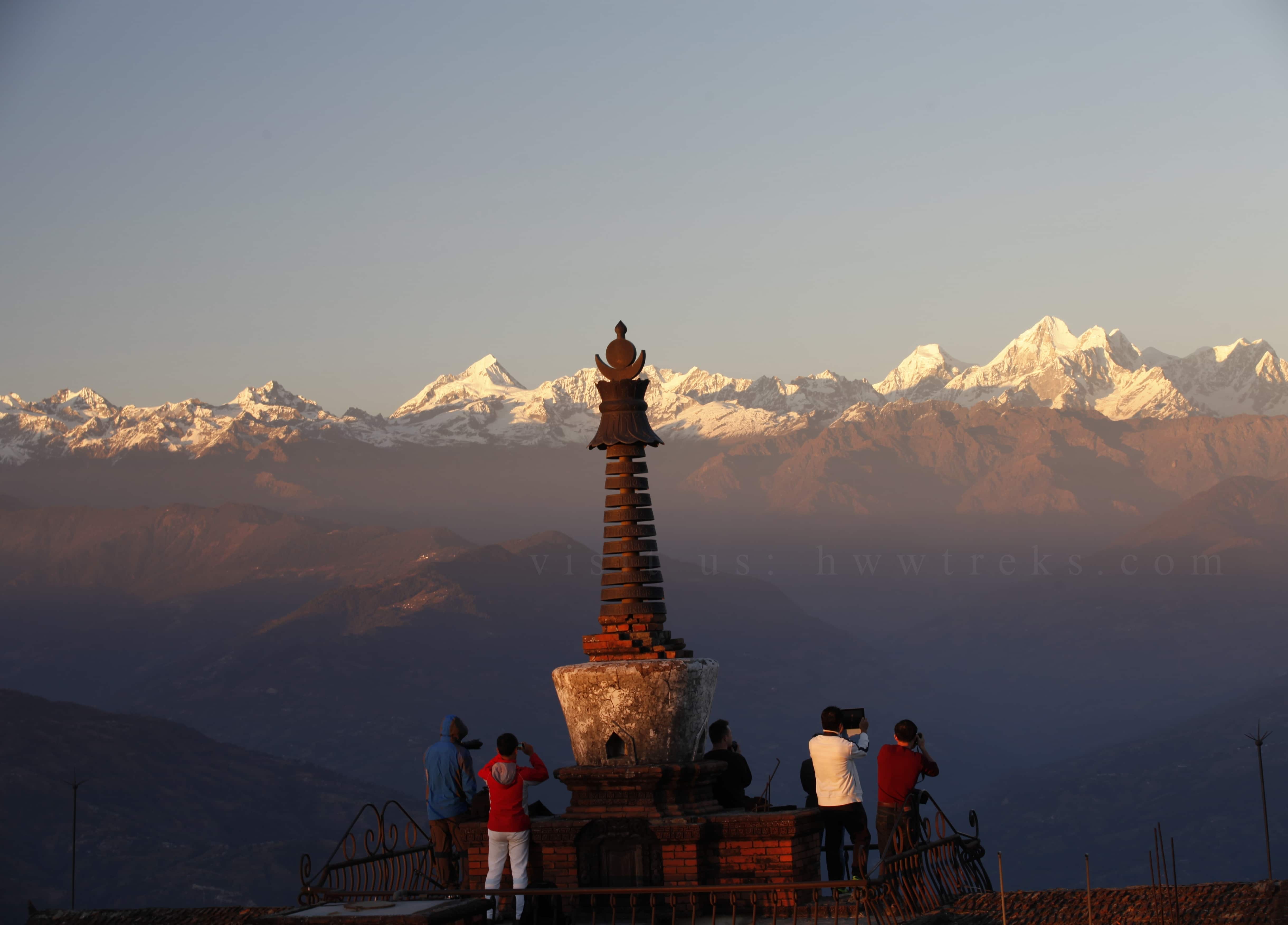 Trekking and hiking are physical activities, and if you are thinking about the advantages of this activity, then you can make a list of many health and mental benefits, such as:
Trekking and hiking are physical activities, and if you are thinking about the advantages of this activity, then you can make a list of many health and mental benefits, such as:
- Better and improved cardiovascular health
- Increase muscle power, such as legs, arms, glutes, and refined stamina
- Proper weight management, enhanced balance, and flexibility
- Improved immune system
- Improved sleep schedule and mental clarity,
- Free from anxiety and stress.
But all these are the fundamental benefits that one can gain by trekking anywhere in the world. Then why trek in Nepal, and what’s so different about Nepal?
While trekking in Nepal, you will not just have all those mentioned health and mental benefits, but also the following:
- Gaining countless memories and experiences that no other place in the world can beat.
- Get to see the world’s highest peaks (including Mount Everest, Annapurna, Kanchenjunga, Dhaulagiri, and so on)
- Chance to witness the endangered animals such as red panda, one-horned rhino, or even snow leopard(if u get lucky enough)
- Opportunity to observe the wildflowers, lists of Laliguras, butterflies, and many more
- Receiving countless favors and protection from the traditional temples and monasteries
- Able to celebrate the local festivals and share local values and rituals
- Get to experience nomadic life in Upper Dolpo and Upper Mustang
In short, trekking in Nepal is not just a training for your body and mind, but also a journey through breathtaking landscapes, a deep immersion into its rich culture, spiritual traditions, and rare natural wonders, making it an experience unlike anywhere else on Earth.
9. Hospitality in the Himalayas
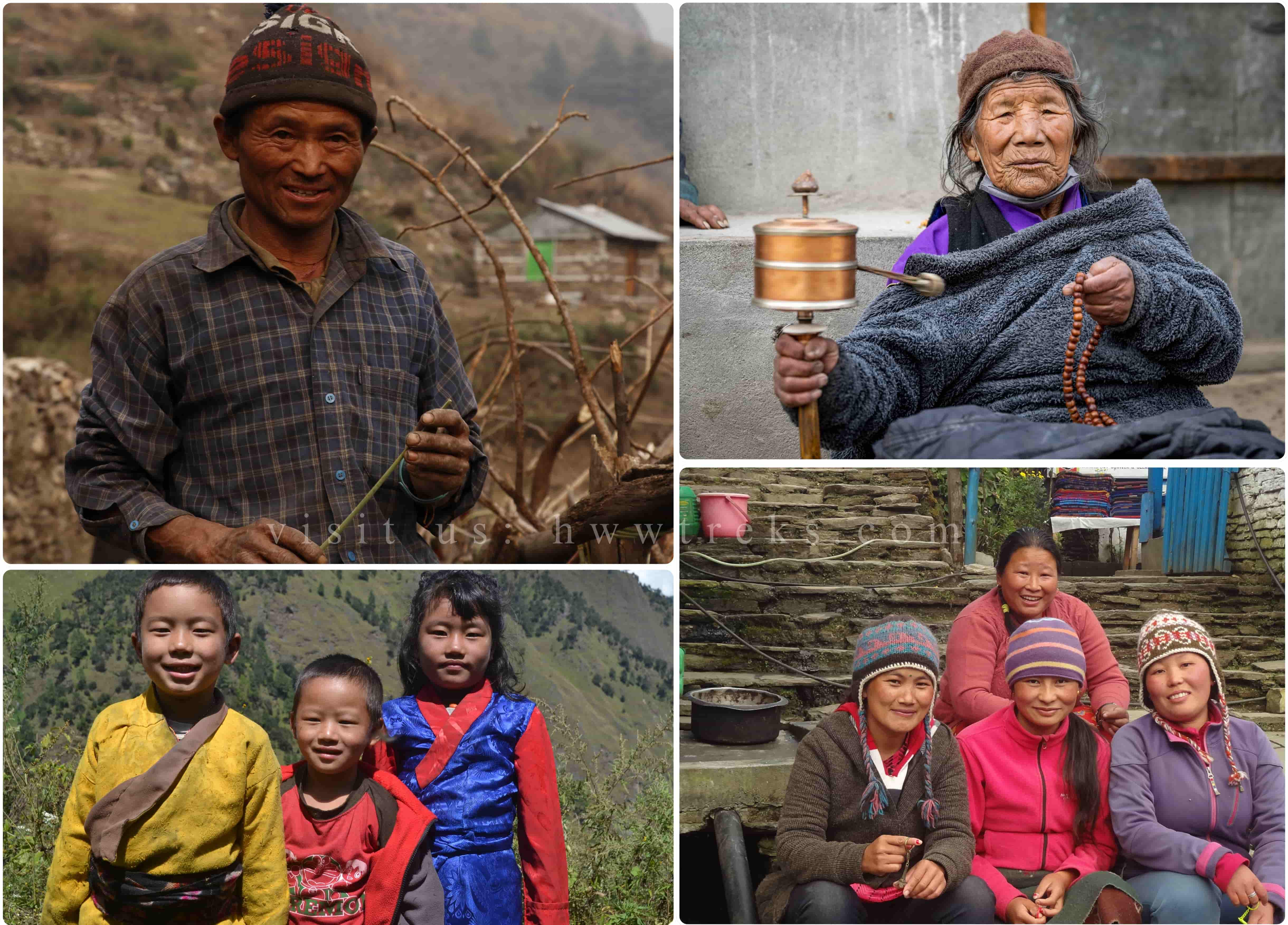 In Nepal, guests are regarded as gods, and offering warm hospitality is deeply rooted in Nepali culture. After trekking in Nepal, people not only remember the landscape, mountains, and monasteries, but they also embrace the warmth and comfort they receive from the Nepali people in their hearts. From the moment you set foot on the airport, you will see many smiling and welcoming people greeting you with a warm “NAMASTE” by joining their hands together. While travelling in and around the Kathmandu valley, you will receive many smiles and “Hellos” from strangers.
In Nepal, guests are regarded as gods, and offering warm hospitality is deeply rooted in Nepali culture. After trekking in Nepal, people not only remember the landscape, mountains, and monasteries, but they also embrace the warmth and comfort they receive from the Nepali people in their hearts. From the moment you set foot on the airport, you will see many smiling and welcoming people greeting you with a warm “NAMASTE” by joining their hands together. While travelling in and around the Kathmandu valley, you will receive many smiles and “Hellos” from strangers.
Along your journey, you will meet fellow travellers, friendly shopkeepers, hardworking farmers, and many curious children, greeting you and accepting you with an open heart. The trekking guide and the porters will become more than just your trekking crew members. They will be with you from the start to the end of your trek, sharing stories, laughter, and encouragement. They will be your Tenzings, much like Edmund Hillary had his. The guides and porters of Nepal are much more than storytellers of history, culture, and tradition of the respective place; they are professional and trained individuals who can deal with any emergencies, so you can rely on them throughout the journey and proceed with peace of mind. Even in the most remote Himalayan village, the hotel and teahouse owner will greet you with genuine laughter, offering hot tea and a warm fire after a long day on the trail. This heartfelt hospitality will make you feel at home, even at 4,000 meters above sea level.
Whether you are trekking to the top of the world or crossing high passes, or simply visiting Kathmandu valley, the affectionate and humble people of Nepal will leave an unforgettable impression that will last longer than your trek memory. These experiences offer the trekkers and travellers a peek into Nepali culture and daily life, making it a reason for them to trek to Nepal one more time.
Conclusion
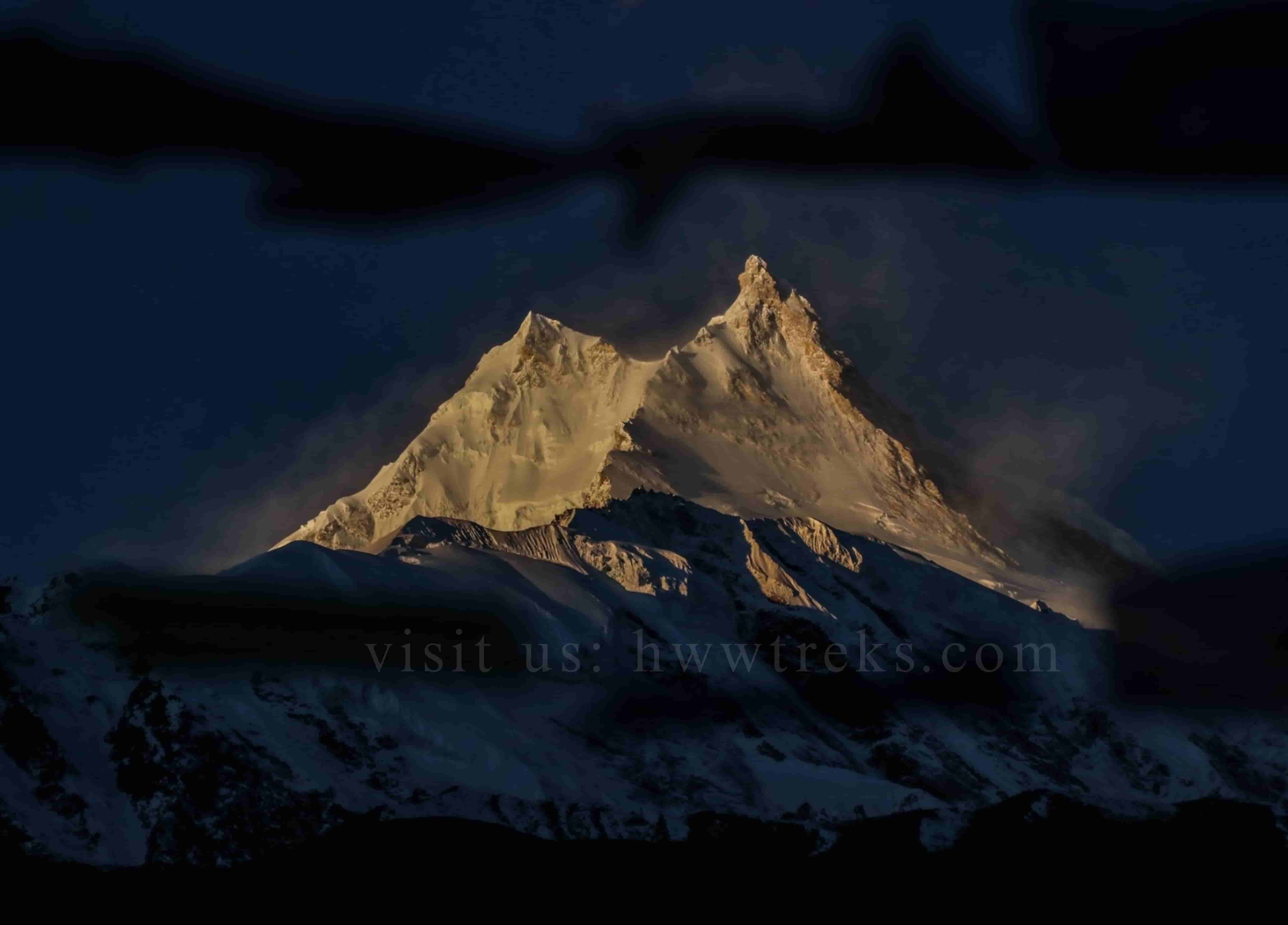 Trekkers leave Nepal carrying more than just photos; they take home memories of towering peaks, warm smiles, and trails that change the way they see the world. The mountains, culture, and untouched landscapes stay etched in their hearts long after the trek ends. From the breathtaking biodiversity to the living traditions, every step in Nepal feels like a story worth telling again and again. Whether you’re seeking adventure, peace, or cultural discovery, Nepal gives you more than you expect. So, pack your bags, choose your trail, and get ready to set foot on the Himalayas.
Trekkers leave Nepal carrying more than just photos; they take home memories of towering peaks, warm smiles, and trails that change the way they see the world. The mountains, culture, and untouched landscapes stay etched in their hearts long after the trek ends. From the breathtaking biodiversity to the living traditions, every step in Nepal feels like a story worth telling again and again. Whether you’re seeking adventure, peace, or cultural discovery, Nepal gives you more than you expect. So, pack your bags, choose your trail, and get ready to set foot on the Himalayas.
Read a similar useful blog regarding trekking and travelling to Nepal and its region:
- Everything you need to know about the Kanchenjunga Trek
- Manaslu Trekking and Tips
- Upper Mustang Trekking Guide
- Tiji Festival of Upper Mustang
- Tsum Valley Trek Guide
- Rolwaling and Lapche Valley Guide
- An essential guide and Top Tips for trekking in the Dolpo Region of Nepal
- Everest Base Camp Trek Guide
- Best Treks in Nepal: Highly Recommended Treks
- My Inner Dolpo Trek Experience
- Shyagya Tradition of Tsum Valley
- Airports of Nepal
- High Passes Trek In Nepal
- My North Annapurna Base Camp Trek Experience
Frequently Asked Questions
Find answers to common questions about our services
To get Nepal’s visa, one can apply from their home country or can get an on-arrival visa at the TIA(Tribhuvan International Airport), and for that, you need passport-size photos and some amount of currency in your hand. One thing that every traveler needs to keep in mind is that their passport must have a valid date of at least 6 months and a whole page free for a visa. Read more about Nepal’s Visa.
Yes, one can do a solo trek in Nepal, but having a guide is highly recommended. Many trails cover remote and rugged areas, and a guide will ensure safety, smooth navigation, and proper acclimatization. Guides will also provide valuable insights into the local culture, history, and landscapes, and they can assist with any issues, such as changing plans due to weather-related flight delays in Lukla or Jomsom, or any emergency transport facility.
In Nepal, the cost of trekking permits depends on the season, and on the region, which might include some restricted areas such as the Upper Mustang and Upper Dolpo region cost USD 50 per day for all season, whereas Tsum Valley area cost USD 40 per person/week during September – November and USD 30 per person/week during December – August. Read here about the Nepal Trekking permit and cost.
While packing for the trek, you'll need sturdy trekking shoes, warm clothing, a sleeping bag, water bottles, sunscreen, a hat, energy snacks, and a small first-aid kit. Make sure to pack light but wisely to stay comfortable during the trek, keeping in mind the varying weather conditions. Read more about the trekking gear and equipment.
Yes, Nepal is safe to visit. The people here are very welcoming and humble towards each other and the foreigners. Nonetheless, one needs to be careful and must avoid walking or traveling to isolated areas, solo trek and and should be conscious about their belongings and where they are.
Yes, one can find atm facility in every corner of Nepal except for some remote villages (even though they have a bank and atm service at the nearby market). In major cities like Kathmandu and Pokhara, there are 24-hour ATM services, and travellers can use their own international visa or master cards.
Alongside trekking in mountains, Nepal offers a lot of experiences such as exploring religious and ancient temples, monasteries, heritages and cities, jungle and wildlife safaris, cultural tours, heli tours to mountains and cities, and many more.
Altitude sickness can occur in regions above 2,500 meters(8,200 feet), and most of the trekking areas, namely Everest, Annapurna, Kanchenjunga, and several others, take you to elevations over 4,200 meters, so you might face some symptoms of altitude sickness. At that time, proper acclimatization is important. Staying hydrated, avoiding exertion, and listening to your body are essential. If symptoms of altitude sickness occur and get severe, your guide should assist you in descending to a lower altitude for recovery.
For trekking in Nepal, one needs to be physically fit enough to walk or hike for 5-6 hours a day. Beyond that, there are no strict requirements, as people of all ages and experience levels can trek, choosing routes that match their preferences and abilities.
No questions found matching your search. Try different keywords or browse all questions above.
